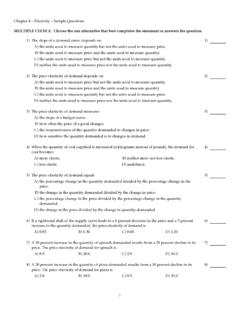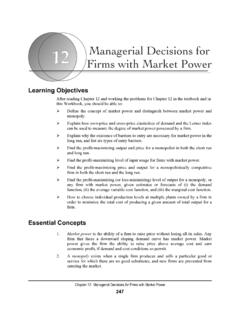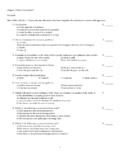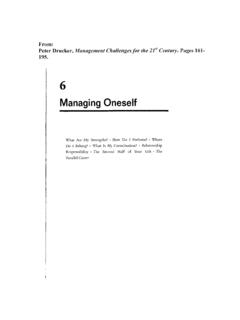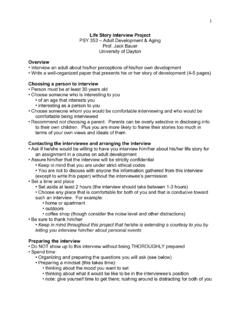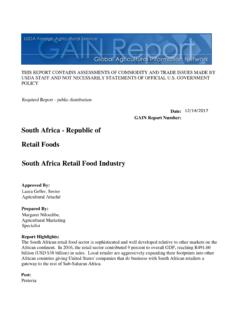Transcription of Chapter 2 The Economic Problem MULTIPLE CHOICE. Choose …
1 Chapter 2 The Economic Problem Test Bank MULTIPLE CHOICE. Choose the one alternative that best completes the statement or answers the question. 1) The production possibilities frontier 1). A) refers to the technology used in such goods as computers and military aircraft. B) marks the boundary between attainable combinations of goods and services and unattainable combinations. C) once applied to technology but now refers to Japanese technology. D) is also called the supply curve. 2) The production possibilities frontier is the boundary between 2). A) those combinations of goods and services that can be produced and those that can be consumed. B) those combinations of goods and services that can be produced and those that cannot. C) those resources that are limited and those that are unlimited. D) those wants that are limited and those that are unlimited. 3) The production possibilities frontier is the boundary between those combination of goods and 3).
2 Services that can be A) produced and those that can be consumed. B) consumed domestically and those that can be consumed by foreigners. C) consumed and those that cannot be produced. D) produced and those that cannot be produced. 4) The production possibilities frontier is 4). A) downward sloping and reflects tradeoffs in choices. B) downward sloping and reflects unlimited choices. C) upward sloping and reflects tradeoffs in choices. D) upward sloping and reflects unlimited choices. 5) The production possibilities frontier 5). A) depicts the boundary between those combinations of goods and services that can be produced and those that cannot given resources and the current state of technology. B) shows how many goods and services are consumed by each person in a country. C) is a graph with price on the vertical axis and income on the horizontal axis. D) is a model that assumes there is no scarcity and no opportunity cost.
3 6) The production possibilities frontier illustrates 6). A) all goods that can be produced by an economy. B) all goods and services that are desired but cannot be produced due to scarce resources. C) the combination of goods and services that can be produced efficiently. D) all possible production of capital goods. 7) The production possibilities frontier represents 7). A) the maximum levels of production that can be attained. B) the maximum amount of resources available at any given time. C) combinations of goods and services that do not fully use available resources. D) the maximum rate of growth of output possible for an economy. 1. 8) A production possibilities frontier does NOT illustrate 8). A) attainable and unattainable points. B) the exchange of one good or service for another. C) the limits on production imposed by our limited resources and technology. D) opportunity cost. 9) Any production point outside the production possibilities frontier 9).
4 A) is attainable only if prices fall. B) is associated with unused resources. C) is attainable only if prices rise. D) is unattainable. 10) Which of the following statements regarding the production possibilities frontier is true? 10). A) Points on the frontier are less efficient than points inside the frontier. B) Points inside the frontier are attainable. C) Points outside the frontier are attainable. D) None of the above because all of the above statements are false. 11) Jane produces only corn and cloth. Taking account of her preferences for corn and cloth 11). A) makes her production possibilities frontier straighter. B) does not affect her production possibilities frontier. C) makes her production possibilities frontier flatter. D) makes her production possibilities frontier steeper. 12) On the vertical axis, the production possibilities frontier shows _____; on the horizontal axis, 12). the production possibilities frontier shows _____.
5 A) the quantity of a good; a weighted average of resources used to produce the good B) the quantity of a good; the number of workers employed to produce the good C) the quantity of a good; the price of the good D) the quantity of one good; the quantity of another good 13) Scarcity is represented on the production possibilities frontier by 13). A) the fact that there are only two goods in the diagram. B) technological progress. C) the amount of the good on the horizontal axis forgone. D) the fact there are attainable and unattainable points. 2. 14) The above figure illustrates that if this country wishes to move from its current production 14). point (labeled "Current") and have 10 more tons of food, it can do this by producing A) 10 more tons of clothing. B) 5 fewer tons of clothing. C) 5 more tons of clothing. D) 10 fewer tons of clothing. 15) A point inside a production possibilities frontier 15).
6 A) implies that too much capital and not enough labor are being used. B) is more efficient than points on the production possibilities frontier. C) could indicate that some resources are unemployed. D) is unattainable. 16) A point inside a production possibilities frontier 16). A) could indicate that resources are misallocated. B) implies that too much labor and not enough capital is being used. C) is more efficient than a point on the production possibilities frontier. D) reflects the fact that more technology needs to be developed to fully employ all resources. 17) When resources are assigned to inappropriate tasks, that is, tasks for which they are not the 17). best match, the result will be producing at a point A) outside the PPF. B) where the slope of the PPF is zero. C) inside the PPF. D) where the slope of the PPF is positive. 18) Production efficiency requires that 18). A) we are producing at a point on the PPF.
7 B) resources be assigned to the task for which they are the best match. C) we cannot produce more of one good without producing less of some other good. D) All of the above answers are correct. 3. 19) Sam's production possibilities frontier has good A on the horizontal axis and good B on the 19). vertical axis. If Sam is producing at a point inside his frontier, then he A) can increase production of both goods with no increase in resources. B) values good A more than good B. C) values good B more than good A. D) is fully using all his resources. 20) A situation in which some resources are NOT fully utilized is represented in a production 20). possibilities frontier diagram by A) a point inside the production possibilities frontier. B) the midpoint of the production possibilities frontier. C) a point outside the production possibilities frontier. D) any point on either the horizontal or the vertical axis.
8 21) Production points inside the production possibilities frontier 21). A) are associated with unused or misallocated resources. B) result in more rapid growth. C) are unattainable. D) are attainable only with the full utilization of all resources. 22) A nation produces at a point inside its PPF 22). A) when it produces inefficiently. B) never. C) when it trades with other nations. D) when its PPF is bowed out. 23) Refer to the production possibilities frontier in the figure above. Which point indicates that 23). resources are NOT fully utilized or are misallocated? A) point a B) point b C) point c D) point e 24) Refer to the production possibilities frontier in the figure above. Which point is unattainable? 24). A) point a B) point b C) point c D) point e 4. 25) Refer to the production possibilities frontier in the figure above. Point _____ represents an 25). _____ point. A) b; unattainable B) c; unattainable C) c; inefficient D) e; inefficient 26) In the figure above, moving from point d to point a requires 26).
9 A) technological change. B) a decrease in unemployment. C) both capital accumulation and a decrease in unemployment. D) decreasing the output of consumer goods in order to boost the output of capital goods. 27) Refer to the production possibilities frontier in the figure above. Suppose a country is at point a. 27). A movement to point _____ means that the country _____. A) d; must give up 20 million capital goods B) d; gives up 10 million consumer goods C) b; is producing at an inefficient point D) e; is not operating efficiently 28) Refer to the production possibilities frontier in the figure above. If the country moves from 28). point a to point c, the opportunity cost of the move is A) 10 million capital goods. B) 30 million capital goods. C) 10 million consumption goods. D) 20 million capital goods. 29) Some time ago the government of China required many highly skilled technicians and 29). scientists to engage in unskilled agricultural labor in order to develop "proper social attitudes.
10 ". This policy probably caused China to produce A) at an inappropriate point along its production possibilities frontier. B) inside its production possibilities frontier. C) outside its production possibilities frontier with respect to food, but inside with respect to high-technology goods. D) inside its production possibilities frontier with respect to food, but outside with respect to high-technology goods. 30) Production efficiency is achieved 30). A) when all goods and services desired by consumers can be produced in the economy. B) when the ability is gained to produce goods and services that are desired beyond the PPF. boundary. C) when producing inside the production possibilities frontier. D) when it producing one more unit of one good cannot occur without producing less of some other good. 31) A society that is producing on its production possibilities frontier is 31). A) fully utilizing all of its productive resources.
